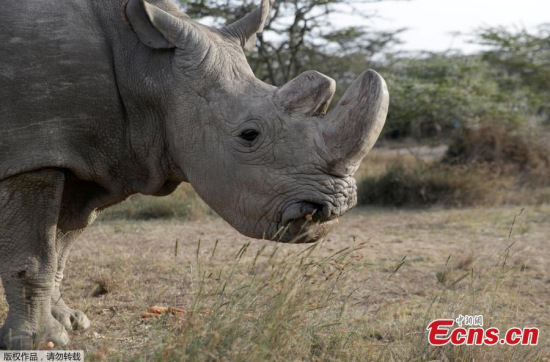
File photo: The last surviving male northern white rhino named "Sudan" is seen at the Ol Pejeta Conservancy in Laikipia, Kenya June 18, 2017. (Photo/Agencies)
The death of the last remaining male northern white rhino to roam planet earth, which was announced on Tuesday by its care taker, Ol Pejeta Conservancy in northern Kenya, had shocked global wildlife campaigners while triggering a new debate on effective ways to protect endangered species from extinction.
Nicknamed Sudan, the 45-year-old world's only remaining male northern white rhino was declared dead after battling age related complications since the beginning of this March.
Ol Pejeta Conservancy said that veterinary doctors decided on Monday to euthanize Sudan after it became apparent that he could not survive an onslaught of age related disorders.
"His condition worsened significantly in the last 24 hours; he was unable to stand up and was suffering a great deal. The veterinary team from the Dvur Kralove Zoo, Ol Pejeta and Kenya Wildlife Service made the decision to euthanize him," Ol Pejeta said in a statement released on Tuesday.
The news of Sudan's demise sent shockwaves in the global conservation and scientific communities given its enviable status as the last northern white male rhino in the world.
Richard Vigne, the CEO of Ol Pejeta, echoed the sentiments of local and international wildlife campaigners by stating that Sudan's demise was a huge blow to the concerted efforts to save iconic but threatened species.
"We on Ol Pejeta are all saddened by Sudan's death. He was a great ambassador for his species and will be remembered for the work he did to raise awareness globally of the plight facing not only rhinos, but also the many thousands of other species facing extinction as a result of unsustainable human activity," said Vigne.
"One day, his demise will hopefully be seen as a seminal moment for conservationists worldwide," he added.
Born in the Sudanese wild in 1973, the giant land mammal was later transferred to a zoo in Europe where it lived until 2009 when it was relocated to the 90,000 acres Ol Pejeta Conservancy located in Kenya's Laikipia County.
Sudan has left behind a daughter named Najin and a granddaughter called Fatu who have lived with him at the Ol Pejeta Conservancy since 2009.
Due to advanced age, Sudan was unable to reproduce with the planet's two last remaining northern white female rhinos.
In the last couple of years, global wildlife campaigners have spearheaded a campaign to enable Sudan to sire offspring with the two female northern white rhinos using modern reproductive technologies like In Vitro Fertilization (IVF).
The campaigners last year launched a campaign to raise some 9 million dollars to enable Sudan to reproduce with his female counterparts using artificial methods.
Despite failed attempts to reproduce the next generation of northern white rhinos, conservationists were optimistic that modern technology could offer a respite in the near future.
"His genetic material was collected yesterday and provides a hope for future attempts at reproduction of northern white rhinos through advanced cellular technologies," said Ol Pejeta Conservancy.
"The only hope for the preservation of this subspecies now lies in developing in vitro fertilization (IVF) techniques using eggs from the two remaining females, stored northern white rhino semen from males and surrogate southern white rhino females," it added
Before his demise, Sudan was put under 24 hour armed surveillance at the Ol Pejeta Conservancy to ward off attack by poachers who are responsible for rapid decline in the population of African rhinos.
Statistics from wildlife conservation lobby groups indicate the population of northern white rhino subspecies stood at 2,000 in the 1960s but later dropped to the current two due to poaching, habitat loss and climatic shocks.
Scientists and wildlife campaigners still reeling from the shock of Sudan's death are banking on artificial reproductive technologies to halt the extinction of northern white rhinos.
"We must take advantage of the unique situation in which cellular technologies are utilized for conservation of critically endangered species," remarked Jan Stejskal, the Director of International Projects at Dvur Kralove Zoo which once sheltered Sudan.
It may sound unbelievable, but thanks to the newly developed techniques, even Sudan could still have an offspring," he added.


















































